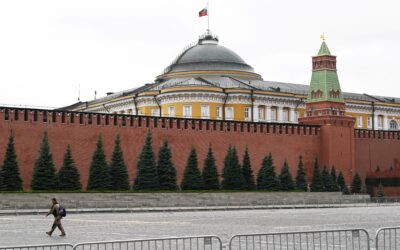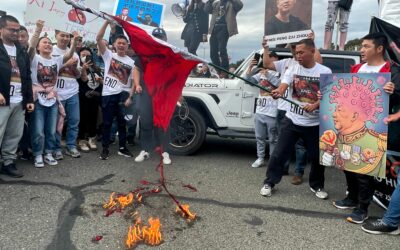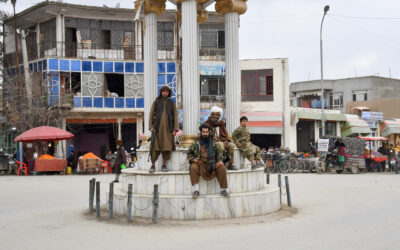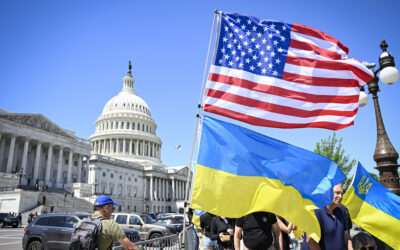
Russia’s Response to U.S. Aid: Shrugs, Disinformation and Warnings of Nuclear War
SUBSCRIBER+ EXCLUSIVE REPORTING — Russia’s reaction to the new infusion of U.S. aid for Ukraine has ranged from shrugs to fury, from warnings of nuclear […] More
Most Americans will never have the opportunity to see, or fully understand, the training that goes into protecting the homeland. Whether it’s a hurricane bearing down on the coastline or a terrorist event, there are a multitude of government specialists who are trained to respond. A centerpiece of that training comes from the National Exercise Program and specifically, the biannual National Level Exercises.
These exercises, known in short-hand as NLEs, are major preparedness opportunities designed to improve national resiliency. These are the training simulations you rarely hear about because take place out of the public view, but they are vital to ensuring public safety. The ability to minimize the negative effects of physical attacks inside the United States is essential to strategic and operational deterrence, as well as ensuring presidential decision space.
Homeland Editor Todd Rosenblum talked with Cipher Brief expert Lieutenant General Guy Swan III (ret.) who served as the Commanding General of U.S. Army North (ARNORTH) and former Acting Director of Operations for U.S. Northern Command (NORTHCOM) and the HON. Paul F. McHale, who served as the former Assistant Secretary of Defense for Homeland Defense and Americas’ Security Affairs (ASD) and asked for an inside understanding of the training and why we do it.
Rosenblum: Few outside the homeland security community are familiar with the FEMA-led National Level Exercise (NLE) conducted each year to test the nation’s readiness to respond to a man-made or natural disaster in the homeland. Can you describe the size, scale and scope of NLE 2018?
Swan/McHale: First a bit of history. Many readers will remember the term “TOPOFF,” short for Top Officials, which was a homeland security-centric series of exercises administered by FEMA that were established in May 2000, well before the attacks of 9/11. This series of exercises continued until 2009 when the National Exercise Program was reformatted and has now become a biennial exercise series.
Today, the intent of these exercises is to focus the whole of nation effort at all levels from the local, state, tribal, and territorial levels right up to the federal government, on preparing for wide-scale emergency events – anything from a natural disaster to a terrorist attack or worse. As one would expect, the focus of these exercises is adjusted during each two-year cycle to keep pace with the changing global and homeland threat environment.
When we say ‘exercises’ we are talking about a multi-echelon structure under which numerous exercises are conducted at various levels of government and in the private sector. All these drills are linked to an overarching scenario or set of national objectives that examine and validate capabilities in the prevention, protection, mitigation, response, and recovery phases of a large-scale event.
This elaborate structure is intended to test and refine plans and build relationships which will ensure that elected officials, first responders, emergency managers, supporting military units from NORTHCOM, Army North, and the National Guard, private industry, and NGOs are operating in a mutually supportive manner during major emergencies or catastrophic incidents.
The comprehensive nature of NLE 2018, conducted during May, was impressive. The exercise looked at how best to protect against, respond to, and recover from a major mid-Atlantic hurricane. Clearly, this was a response to the major impact that hurricanes had on the U.S. in 2017.
Over 12,00 individuals participated across 67 local jurisdictions in 6 states and included over 160 private sector organizations and 91 federal agencies.
Rosenblum: How do national leaders decide on the exercise topic? National leaders have long bench marked detonation of a 10 KT nuclear device in the homeland as the outer limit for testing our National Response Framework. Do you support this as the right maximum stress test for responding to man-made disasters in the homeland? How do we test for resiliency against attacks on the nation’s critical infrastructure, including on the energy sector? Do we try to address other key threat vectors like pandemic, a chemical/biological/radiological weapons attack? What’s the right benchmark for natural disasters, like wild fires and devastating earthquakes?
Swan/McHale: The two-year NLE exercise cycle starts at the National Security Council where the Principals Committee sets the overarching objectives. The final 8-10 guiding principles are based on an exhaustive study of strategy and policy documents (National Security Strategy, National Preparedness System, Strategic National Risk Assessment, etc.), preparedness data from state and federal agencies, the results of previous exercises, and real-world incidents (California wildfires, mass shootings, terrorist-related incidents at home and abroad).
Early on, the effects of a 10-kt nuclear device detonation were used as the baseline scenario as the exercise was intended to test virtually every component of the nation’s response and recover capability. It serves as a “major disaster” as envisioned by the Stafford Act, which lays out authorities for national emergency response. Ideally, an NLE scenario moves beyond a “major disaster,” rising to the level of a “catastrophic event” which stresses the entire national response enterprise.
A past Chairman of the Joint Chiefs once said that he considered a “catastrophic event” to be one in which there was a likelihood of more than 10,000 dead civilians affected and could require as many as 75,000 – 100,000 trained and equipped response personnel (as in the Hurricane Katrina or Fukashima nuclear disaster scenarios), most of whom would be military personnel (Title 10 and Title 32) serving in a Defense Support of Civil Authorities (DSCA) capacity. This was fine for several years, but more recently the National Exercise Program has become more flexible and is accounting for a wide variety of threats and hazards.
For 2020, we will see objectives as far reaching as: intelligence and information sharing, cyber coordination, infectious disease and biological incidents, mass care and housing, national security emergencies, and school safety and security.
With those objectives in hand, the National Exercise Directorate at FEMA is already working with its network of local, state, tribal, territorial, and federal partners to craft a scenario wide enough to address each objective.
With the growing concern over foreign adversaries threatening the homeland in new ways, it is quite likely that NLE 2020’s scenario will emanate from abroad, involve extensive cyber-attacks impacting national critical infrastructure and the resultant catastrophic effects on the U.S. population.
Rosenblum: What happens after the annual NLE? How robust is the ‘lessons learned’ process? Are there repeating short comings identified year-after-year, like limited inter-operable communications equipment?
Swan/McHale: As retired military officers who have spent years training and exercising military units and working with civil authorities, we can say unequivocally that exercises are only truly effective when an honest after-action review of the results is conducted and most importantly, that action is taken to improve tactics, techniques, and procedures, adjust resource allocations, and get buy-in from all players.
While this has been hit-and-miss over the years, we have seen improvement, especially in jurisdictions and agencies where senior leaders – not just staffers – are personally involved in the process.
We must also be courageous enough at all levels to face the shortcomings, inadequacies, and weaknesses – even failures – that are always discovered during the NLE process. Some leaders are uncomfortable or even afraid to reveal such results to their constituencies for fear of being criticized as ineffective or incompetent. It’s clear to us that it’s better to identify and fix weaknesses in the exercise environment than to face human catastrophe during a major national crisis.
Rosenblum: Have you seen progress over the years in the sophistication of the exercise, level of participation and actual adjustments to policy and capability afterward? What’s your evaluation of the 2018 NLE in May that posited a major, devastating hurricane in the Hampton Roads, VA area? Did the exercise identify specific challenges for the U.S. military, including overseas operations?
Swan/McHale: The National Exercise Program and the discrete National Level Exercises are improving. The exercises are now built around incidents that have happened or are likely to happen. This ‘real-world’ view is indeed more sophisticated and adds a sense of urgency to the overall effort.
This is especially true when participants have a vested interest, as we saw in May. For example, the U.S. Navy and the broader Department of Defense are indeed very concerned about the effects of rising sea levels at coastal bases like Norfolk, VA and elsewhere around the world. NLE 2018 provided a training and exercising opportunity to look at current and future plans and programs for dealing with this emerging hazard, one which will have significant operational impacts on the U.S. military’s ability to deploy and sustain its forces globally.
The goal of NLE 2020 is to provide all participants a scenario that “hits close to home” as opposed to being just an academic exercise.
Rosenblum: Are NLEs attempting to wrestle with the possibility of foreign information operations designed to sow confusion during response?
Swan/McHale: Absolutely. State and non-state actors continue to pose a cyber threat in a variety of areas and this includes emergency management. This threat also extends to criminal groups which have already struck local and state agencies and jurisdictions – like the Colorado Department of Transportation and the City of Atlanta – with ransomware attacks. Planners at all levels continue to be concerned that these attacks could adversely affect the public information domain, especially at a time when citizens depend on clear and accurate information. The resultant confusion could delay a timely life-saving response.
We believe that it’s essential for future NLEs to fully anticipate foreign interference (IO operations) and follow-on cyberattacks during the execution of any defense support of civil authorities mission executed in the aftermath of a catastrophic event, especially if the original triggering event was a terrorist attack or nation-state act of aggression. Ruthless exploitation by our adversaries is almost inevitable. Moreover, NLEs should recognize and anticipate our nation’s heightened vulnerability to foreign attack, including hostile cyber operations, during defense support operations following a catastrophic natural disaster. Indeed, a major natural disaster may be powerful catalyst for a long-planned foreign attack.
Maintaining public confidence and cooperation during the response phase of a national emergency is vital – it is also a vulnerability that must be addressed and trained for. We anticipate this emerging threat to be front and center in NLE 2020.
Rosenblum: What do you see as the future of NLEs? Are they trending in the right direction? How would you like to see them evolve in the future?
Swan/McHale: In our experience, NLEs tend to underemphasize the realities of logistical support (the real-world challenge of providing a timely response, both in personnel and equipment). This needs to be a major objective in future NLEs.
As mentioned earlier, in the case of large-scale military response forces needed for a catastrophic event, an NLE should and must help codify the need for pre-identified and trained forces that can be task-organized and deployed in a timely manner – all while continuing to support overseas contingencies. Bottom line: NLEs need to be realistic in terms of the timeline for an effective response – and the time needed to identify, shape, and deploy the federal response force. Right now, that is a major shortcoming.
Finally, there is not enough public awareness of the National Level Exercise. FEMA and the Department of Homeland Security – and frankly, all of us – need to do a better job of publicizing the next NLE. It should be a true national effort. This will go a long way toward gaining the public’s confidence and when needed, their cooperation.
Rosenblum: Do you see technology solutions that will improve execution of the National Response Framework (NRF)?
Swan/McHale: Our ability to link disparate and disperse exercises together digitally has improved since the first TOPOFF exercises. That’s a positive. In addition to assisting in the execution of the exercise, technological tools used are informing the ever evolving NRF.
The situational understanding among key leaders needed to execute the NRF is also improving. But most first responders, emergency managers, military commanders, and elected leaders will tell you that we are still in search of the Holy Grail – the elusive common operating picture (COP).
The National Exercise Program and the National Level Exercise is helping us get there.
Related Articles

SUBSCRIBER+ EXCLUSIVE REPORTING — Russia’s reaction to the new infusion of U.S. aid for Ukraine has ranged from shrugs to fury, from warnings of nuclear […] More

SUBSCRIBER+ EXCLUSIVE REPORTING — When Chinese President Xi Jinping came to San Francisco last November to meet with President Joe Biden, Chinese pro-democracy activists in […] More

SUBSCRIBER+EXCLUSIVE EXPERT PERSPECTIVE — More than two years after its withdrawal from Afghanistan, the U.S. still does not have a clear way forward in the […] More

SUBSCRIBER+ EXCLUSIVE REPORTING — Ukrainians greeted Saturday’s long-awaited House passage of $60.8 billion in aid with justifiable jubilation. For months, their soldiers, civilians, and political […] More

SUBSCRIBER+ EXCLUSIVE REPORTING — A race for control of space is underway, and just as on earth, the U.S. and China are the top competitors. […] More

SUBSCRIBER+ EXCLUSIVE REPORTING — For nearly a week, the Middle East and much of the world were on a knife’s edge, waiting for a promised […] More
Search